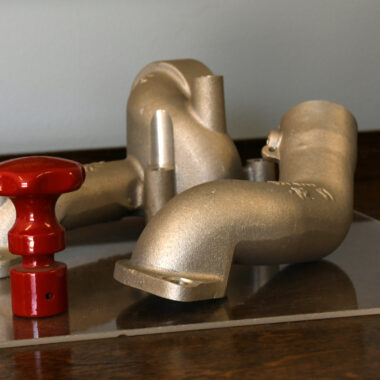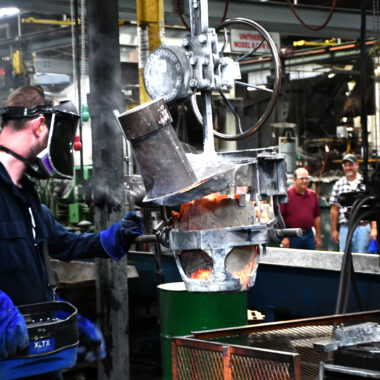Precision in Practice: The Art About Aluminum Casting
Precision in Practice: The Art About Aluminum Casting
Blog Article
Unlocking the Potential of Light Weight Aluminum Spreading: Proven Techniques for Success
Aluminum spreading has long been recognized for its adaptability and widespread applications throughout various sectors. Join us as we explore the crucial components that can drive aluminum spreading in the direction of unequaled success in today's competitive market landscape.
Advantages of Light Weight Aluminum Casting
One of the key advantages of light weight aluminum casting is its light-weight nature, which adds to fuel efficiency in industries such as automotive and aerospace. In addition, light weight aluminum is very malleable, allowing for intricate and complex forms to be quickly produced via spreading processes.
Furthermore, aluminum spreading supplies outstanding corrosion resistance, making it optimal for applications where exposure to rough settings is a worry. The material also shows excellent thermal conductivity, which is helpful for markets requiring warmth dissipation, such as electronic devices (about aluminum casting). Light weight aluminum is fully recyclable, straightening with the expanding emphasis on sustainable practices in modern-day production.
Design Considerations for Casting
When taking into consideration casting style, meticulous interest to detail is paramount to make certain the effective manufacturing of top notch components. The design stage plays a vital function in the general success of an aluminum spreading project. One vital factor to consider is the selection of proper geometries and features that assist in the casting procedure. Developers should consider aspects such as draft angles, fillets, and wall surface density to ensure appropriate steel flow and solidification throughout spreading.
Furthermore, considerations associated with parting lines, gating systems, and risers are necessary to stop flaws like porosity and contraction. It is critical to maximize the design for efficient material usage and reduce post-processing demands. Simulations and prototyping can be useful devices in reviewing and refining the casting style before major production.
Cooperation in between style suppliers, designers, and foundries is crucial to resolve any kind of prospective difficulties early in the style phase. By incorporating these factors to consider right into the casting design process, suppliers can boost product high quality, decrease costs, and inevitably unlock the full possibility of light weight aluminum casting.
Enhancing Casting Efficiency
Designing with a concentrate on maximizing material circulation and lessening defects is essential when intending to enhance casting effectiveness in aluminum spreading projects. To attain this, using simulation software can assist in determining potential concerns before the spreading process starts. By replicating the circulation of liquified aluminum, designers can change gating and riser layouts to guarantee correct filling and solidification, inevitably minimizing the event of problems such as porosity or shrinkage.
Moreover, applying appropriate warmth treatment processes can enhance the overall spreading effectiveness. Heat therapy can aid enhance the mechanical homes of the aluminum spreading, guaranteeing that the last component satisfies the called for specs. Furthermore, utilizing automation and robotics in the spreading procedure can simplify production, reduce manual work, and boost general effectiveness.
In addition, continual surveillance and top quality control throughout the spreading procedure are important for determining any kind of discrepancies and making certain that the end products meet the desired standards. By executing these approaches, manufacturers can enhance casting performance, boost item high quality, and eventually accomplish higher success in light weight aluminum spreading tasks.
Quality Assurance in Light Weight Aluminum Casting

Reliable top quality control techniques play a crucial duty in ensuring the precision and reliability of light weight aluminum spreading procedures. Quality control procedures in aluminum casting encompass a range of tasks intended at promoting details click here for info criteria and determining variances that might compromise the final item.
In enhancement to procedure control, quality assurance in aluminum spreading entails rigorous testing and inspection treatments at different stages of production. Non-destructive screening techniques like ultrasonic testing and X-ray evaluation help detect inner flaws without jeopardizing the integrity of the actors parts. Aesthetic examinations, dimensional about his measurements, and mechanical screening further guarantee that the cast parts meet the required specifications and efficiency standards. By executing durable high quality control methods, aluminum spreading centers can deliver products that fulfill consumer expectations for dependability, high quality, and efficiency.
Making Best Use Of Profitability
To accomplish optimal monetary performance, a comprehensive approach for taking full advantage of success within light weight aluminum spreading operations must be diligently created and carried out. One essential aspect of optimizing productivity in aluminum spreading is maximizing manufacturing efficiency.

In addition, expanding product offerings and exploring brand-new markets can aid expand profits streams. Recognizing consumer requirements and market fads can lead tactical decisions to take advantage of on arising possibilities. Spending in r & d to introduce products or procedures can additionally drive earnings with distinction and consumer fulfillment.
Verdict
In conclusion, aluminum spreading supplies many benefits in terms of style sturdiness, versatility, and cost-effectiveness. By meticulously taking into consideration design considerations, enhancing casting performance, implementing quality assurance actions, and taking full advantage of success, manufacturers can unlock the complete capacity of light weight aluminum casting. This dependable and flexible process has verified to be a successful selection for a large see this range of commercial applications.
In addition, aluminum is extremely malleable, enabling for elaborate and complex shapes to be quickly generated through spreading processes.Reliable quality control methods play a critical function in making sure the accuracy and reliability of aluminum casting processes.In addition to process control, quality control in aluminum spreading involves extensive screening and assessment treatments at various phases of production. By applying durable quality control methods, aluminum casting facilities can deliver products that fulfill customer assumptions for efficiency, high quality, and reliability.
By meticulously thinking about design factors to consider, boosting casting effectiveness, carrying out quality control actions, and making best use of earnings, suppliers can unlock the full possibility of aluminum casting.
Report this page